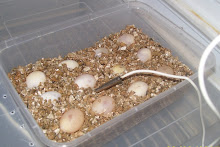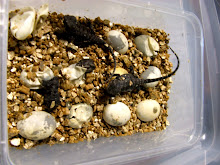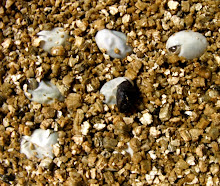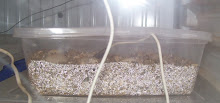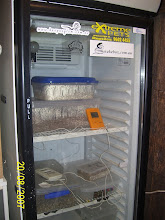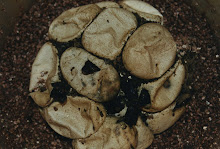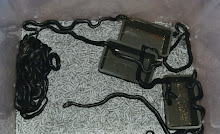Many new reptile keepers don't know what to do when the find they are expecting eggs from there reptiles. They first look for some one with an incubator , and generally get ripped off by giving the other party half their clutch for incubating the eggs , a standard rate is normally two eggs per clutch to cover the cost of power .
Setting up an Incubator from and old fridge or esky is a cheap and easy thing to make. you can get an old drink fridge from a recyclers with double insulated glass fronts. just make sure it has good seals
You can also make one from a container and an aquarium heater for smaller clutches of eggs.
List of items for aquarium container type
2 containers one smaller then the other $13 & $9
1 aquqrium heater $25 to $50
2 bricks free
1 thermometer with external probe $20 to $40
1 aquqrium heater $25 to $50
2 bricks free
1 thermometer with external probe $20 to $40
List of items for esky or fridge type
fridge or esky
2 light bulbs and fittings $15 or more if using a large fridge
Heat tape or heat cord can be used instead if of or in conjunction with the lights
1 or 2 thermostat $35 to $90
1 small 240 volt fan $20 from Dick Smith shops or free out of an old microwave
5 meters 10 amp wire and 1 male three pin plug
you can then wire it your self, if not look for a local electrician and they can do it,and they don’t charge that much if you can take it to there shop.
When you have finished it is wise to turn it on and make sure the heat is distributed evenly through out the incubator, so that there are no hot spot that can cook your eggs.
2 light bulbs and fittings $15 or more if using a large fridge
Heat tape or heat cord can be used instead if of or in conjunction with the lights
1 or 2 thermostat $35 to $90
1 small 240 volt fan $20 from Dick Smith shops or free out of an old microwave
5 meters 10 amp wire and 1 male three pin plug
you can then wire it your self, if not look for a local electrician and they can do it,and they don’t charge that much if you can take it to there shop.
When you have finished it is wise to turn it on and make sure the heat is distributed evenly through out the incubator, so that there are no hot spot that can cook your eggs.
Medium Mix
1:1 by weight vermiculite to warm sterile water
E.g. 200g vermiculite to 200g of water.
I normally boil the jug then let it cool , once cool enough to mix, i mix it in a bucket and set up a few containers ready for the new eggs to be placed in them
E.g. 200g vermiculite to 200g of water.
I normally boil the jug then let it cool , once cool enough to mix, i mix it in a bucket and set up a few containers ready for the new eggs to be placed in them
Incubator Times & Temps
Bearded dragons 30' to 31’ hatching 55 to 60 days
Water dragons 28' to 30' hatching 50 to 60 days
Sand swimmers 28' to 29' hatching 30 days
Geckos 28' to 31' hatching 55 to 60 days
Carpet & children’s pythons 29' to 32' hatching 52 to 60 day
Diamond pythons 28' to 30'hatchlings 55 to 60 days
Monitors 29' to 31’ hatching 70 to 300 day depending on species
Turtles 29' to 31' hatching 55 to 60 days
Low temperatures will take longer to incubate and higher temperatures can cause the embryos to die.
Water dragons 28' to 30' hatching 50 to 60 days
Sand swimmers 28' to 29' hatching 30 days
Geckos 28' to 31' hatching 55 to 60 days
Carpet & children’s pythons 29' to 32' hatching 52 to 60 day
Diamond pythons 28' to 30'hatchlings 55 to 60 days
Monitors 29' to 31’ hatching 70 to 300 day depending on species
Turtles 29' to 31' hatching 55 to 60 days
Low temperatures will take longer to incubate and higher temperatures can cause the embryos to die.
Lizards
If breeding in an out side pit you have to be aware of other species of lizards in the pit when a gravid female is digging to lay her eggs as other will see the eggs as a food source, So they should be removed as soon as posible.
Pythons
Pythons will lay there eggs then curl around them keeping the warm.
As they have the ability to thermo regulate them.
You can move her from the enclosure and remove the eggs to a container
As they have the ability to thermo regulate them.
You can move her from the enclosure and remove the eggs to a container
Out Side Pit Or Enclosure
When you find you have a gravid female lizard in your pit you will notice them basking longer than usual the female will find a nice nest site and start to excavate a nest site, Then she will deposit her clutch of eggs , after which she will cover them over with soil.
Once she has done this the eggs can be dug up, making sure not to roll or turn them , then place them in a container with the incubation medium in it
cover and place in the incubator writing the date on the lid for reference.
Once she has done this the eggs can be dug up, making sure not to roll or turn them , then place them in a container with the incubation medium in it
cover and place in the incubator writing the date on the lid for reference.
Indoor Enclosure
A gravid female in an indoor enclosure will lay in a container of sand slightly moist and no less than 10 cm full is recommended. The eggs need to be removed straight away so as not to dry out.
This can be placed in the enclosure on the other side of the heat source a few weeks before so the gravid female can look and dig for the best spot to lay her eggs rather then just dropping them on the floor of the enclosure.
This can be placed in the enclosure on the other side of the heat source a few weeks before so the gravid female can look and dig for the best spot to lay her eggs rather then just dropping them on the floor of the enclosure.
In The Incubator
During the incubation period you will have to check on the eggs, and any slugs or unfertile eggs can be discarded. An unfertile egg can be discolored
or yellowing of the shell, growing of a fungus on it or just an unpleasant smell or sunken egg shell.
Moister must be monited, some times you might have to add a light misting of water to increase humidity in the container if the medium is drying out. Condensation should be seen on the lid at all times.
Also fanning of the eggs with the lid of the container to replace old air.
Eggs will start to sink as they are about to hatch.
Once your reptiles are starting to hatch you can remove and place in to another container, I like to reduce the temperature by a few degrees now and after a few days I remove them from the incubator and place in a tub or click clack container depending on species.
or yellowing of the shell, growing of a fungus on it or just an unpleasant smell or sunken egg shell.
Moister must be monited, some times you might have to add a light misting of water to increase humidity in the container if the medium is drying out. Condensation should be seen on the lid at all times.
Also fanning of the eggs with the lid of the container to replace old air.
Eggs will start to sink as they are about to hatch.
Once your reptiles are starting to hatch you can remove and place in to another container, I like to reduce the temperature by a few degrees now and after a few days I remove them from the incubator and place in a tub or click clack container depending on species.
Subscribe to:
Comments (Atom)

